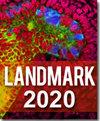Danshensu Attenuated Epithelial-Mesenchymal Transformation and Chemoresistance of Colon Cancer Cells Induced by Platelets.
IF 3.1
4区 生物学
Q2 Immunology and Microbiology
引用次数: 3
Abstract
BACKGROUND The interactions between platelets and tumor cells are well-known to play important roles in the progression of malignant tumors. Danshensu, a main water-soluble component of Salvia miltiorrhiza, can resist platelet aggregation and exert significant anti-tumor effects on various types of tumors. However, whether Danshensu could inhibit the progression of malignant tumors by suppressing the activities of platelets had not been reported. METHODS The effects of Danshensu on the platelet activity and epithelial-mesenchymal transformation (EMT)-like invasive phenotype of SW620 colon cancer cells were assessed by stimulating with the supernatants from co-cultured platelets and SW620 cells with direct contact (SCP). The expression and secretion of proteins were determined by western blot and enzyme-linked immunosorbent assay (ELISA), respectively. Hematoxylin and eosin (H&E) staining was performed to analyzed the histopathology of tumor tissues and immunohistochemical staining was conducted to examine the protein expression in tumors. RESULTS Co-incubation of SW620 cells with platelets directly or SCP both generated long spindle-shaped invasive phenotype. Pretreatment of platelets with Danshensu (25 μM) inhibited the morphological changes of SW620 cells induced by SCP, which was associated with the inhibitory effects of Danshensu on platelet secretion. Danshensu diminished the secretion of a list of biological factors in SCP, including interleukin (IL)-6, tumor necrosis factor alpha (TNF-α), IL-1β and vascular endothelial growth factor (VEGF) that are all involved in tumor cell EMT and chemoresistance. Moreover, Danshensu up-regulated the expression of E-cadherin but down-regulated the levels of N-cadherin and Vimentin, resulting in the repression of SW620 cell migration. It was also shown that Danshensu enhanced the sensitivity of SW620 cells to oxaliplatin by suppressing the expression of MDR1. Furthermore, Danshensu could not only reduced the growth of subcutaneous tumors and liver metastasis that induced by SCP, but also down-regulated the expression of MDR1 in vivo. Mechanistic studies revealed that Danshensu suppressed the activation of the TGF-β/Smad signaling pathway. CONCLUSIONS Danshensu attenuated EMT-like characteristics and chemoresistance by inhibiting secretion capability of platelets and activation of the TGF-β/Smad signaling pathway, suggesting that it may be optimized to be a therapeutic agent for fighting against colon cancer.丹参素对血小板诱导结肠癌细胞上皮间质转化及化疗耐药的影响。
背景血小板和肿瘤细胞之间的相互作用在恶性肿瘤的发展中起着重要作用。丹参素是丹参的主要水溶性成分,具有抗血小板聚集作用,对各类肿瘤均有显著的抗肿瘤作用。然而,丹参素是否能通过抑制血小板活性来抑制恶性肿瘤的进展尚未见报道。方法采用血小板与SW620细胞直接接触(SCP)共培养上清液刺激,观察丹参素对SW620结肠癌细胞血小板活性和上皮间充质转化(EMT)样侵袭表型的影响。western blot和酶联免疫吸附试验(ELISA)分别检测蛋白的表达和分泌。采用苏木精和伊红(H&E)染色分析肿瘤组织的组织病理学,免疫组化染色检测肿瘤组织中蛋白的表达。结果SW620细胞与血小板直接或SCP孵育均产生长梭形侵袭表型。用丹参素(25 μM)预处理血小板可抑制SCP诱导的SW620细胞形态学变化,这与丹参素对血小板分泌的抑制作用有关。丹参素降低了SCP中一系列生物因子的分泌,包括白细胞介素(IL)-6、肿瘤坏死因子α (TNF-α)、IL-1β和血管内皮生长因子(VEGF),这些因子都与肿瘤细胞EMT和化疗耐药有关。丹参素上调E-cadherin表达,下调N-cadherin和Vimentin表达,抑制SW620细胞迁移。丹参素通过抑制MDR1的表达增强SW620细胞对奥沙利铂的敏感性。丹参素不仅能抑制SCP诱导的皮下肿瘤生长和肝转移,还能下调体内MDR1的表达。机制研究表明,丹参素抑制TGF-β/Smad信号通路的激活。结论丹参素通过抑制血小板分泌能力和激活TGF-β/Smad信号通路,减轻了emt样特征和化疗耐药,提示丹参素可能被优化为结肠癌治疗药物。
本文章由计算机程序翻译,如有差异,请以英文原文为准。
求助全文
约1分钟内获得全文
求助全文
来源期刊

Frontiers in Bioscience-Landmark
生物-生化与分子生物学
CiteScore
3.40
自引率
3.20%
发文量
301
审稿时长
3 months
期刊介绍:
FBL is an international peer-reviewed open access journal of biological and medical science. FBL publishes state of the art advances in any discipline in the area of biology and medicine, including biochemistry and molecular biology, parasitology, virology, immunology, epidemiology, microbiology, entomology, botany, agronomy, as well as basic medicine, preventive medicine, bioinformatics and other related topics.
 求助内容:
求助内容: 应助结果提醒方式:
应助结果提醒方式:


